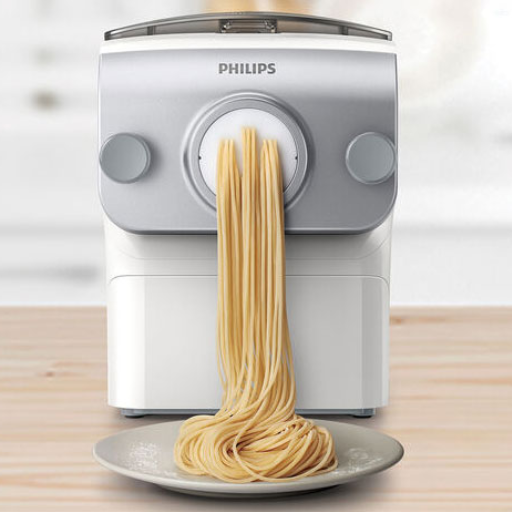Today’s fast world has made cooking and homemade meals a luxury many people want, but few can. However, the allure of new cooked pasta is very appealing to many. This complete guide will help you through the maze of choices for an electric pasta maker to ensure you find one that suits your needs perfectly. Whether you are a beginner or a pro in the kitchen, this manual will explain all about the greatest electric pasta makers available today by outlining their key features, advantages, and aspects worth acknowledging. From simplicity to its maintenance and cleaning aspects, we have addressed it. Learn how easy it is to improve your cooking skills while enjoying the mouth-watering taste of homemade pasta at home.
What is a Pasta Machine, and How Does it Work?
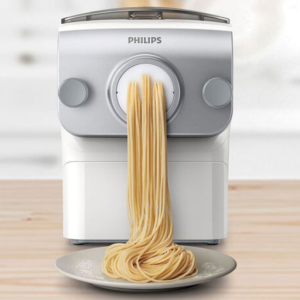
Image source: https://www.thisiswhyimbroke.com/
An automated pasta maker or electric pasta machine is a kitchen device that simplifies the homemade pasta-making process. It works by automatically blending, mixing, and pushing dough with different pasta shapes. Usually, they are equipped with numerous attachments and settings that enable users to determine what type of spaghetti they want to turn their dough into, including fettuccine and penne. First, you place ingredients like flour, water, and eggs into the mixing section of the machine. The appliance does all the work for you: mixing, kneading, and then extruding your dough into different sizes of pasta through dies made for this purpose. Hence, it offers a quick way of turning out homemade pasta that is always consistent, even if hardly any effort is spent on it.
Understanding the Basics of a Pasta Machine
The process of making fresh pasta is simplified by a pasta machine, which automates such necessary tasks as mixing, kneading, and shaping the dough. The mixing and extrusion components on these machines are driven by a motor, constantly ensuring similar texture and shape. Users begin by putting the ingredients they will use, mostly flour, water, and eggs, into the mixing chamber of the machine. After that, the machine blends and kneads the dough into an ideal consistency before pushing it through various dies to make different pasta shapes, such as spaghetti, fettuccine, or penne. Most modern pasta machines also have adjustable settings that allow you to modify the thickness and width of your pasta; this adds versatility to your cooking at home. Electric pasta makers are easy to clean up after use; therefore, anyone who desires a homemade taste should go for them without much effort.
How an Electric Pasta Machine Simplifies Pasta Making
An electric pasta machine can be a time saver for anyone who has tried it. The traditional pasta-making method is too involving because of the need to perform specific vital processes. These machines mix, knead, and shape the dough, minimizing manning power hours. A typical user will only have to feed their ingredients into the machine, which kneads and stirs the dough in equal measure until it gets the right texture. This dough is usually passed through different dies to yield various pasta forms for uniformity and accuracy. In addition, electric pasta makers often come equipped with adjustable settings for width and thickness, allowing one to customize them extensively. Finally, many items are detachable, meaning cleaning up is not difficult for users since they can wash them in dishwashers. Hence, these appliances make fresh homemade pasta accessible to everyone in a very short period without any challenges involved whatsoever.
Manual vs. Electric Pasta Machines: Pros and Cons
When choosing between a manual or electric pasta machine, it is important to weigh the pros and cons of each type to determine what best suits your needs.
Manual Pasta Machines
Pros:
- Cost-effective: In general, it is cheaper than electric models.
- Control: More control over dough consistency and pasta thickness.
- Durability: Often made from solid materials, leading to longer-lasting machines.
- Simplicity: They are less likely to fail due to a lack of electronic components.
Cons:
- Labor-intensive: It requires much work to roll and cut dough manually.
- Time-consuming: It takes more time to produce pasta, unlike electric ones.
- Learning curve: It takes practice and skill to get consistent results.
Electric Pasta Machines
Pros:
- Convenience: This reduces manual labor by automating the mixing, kneading, and shaping processes.
- Speed: It produces pasta quickly and efficiently.
- Consistency: This makes for uniform shapes and thickness in pasta products.
- Versatility: Often, they come with many dies for different shapes and adjustable settings for desired thicknesses.
Cons:
- Cost: More often, they cost more than manual machines
- Complexity: Assembly, usage, or cleaning may be more complex compared to others
- Fragility: Higher electronic content can lead to more mechanical breakdowns; hence, fragility increases
Both types come with their strengths and problems. Manual machines excel in control and durability, whereas electrical ones are convenient and fast. So, the final call will depend on how you feel about these factors relative to your tastes and cooking habits.
How to Choose the Best Pasta Maker Machine?
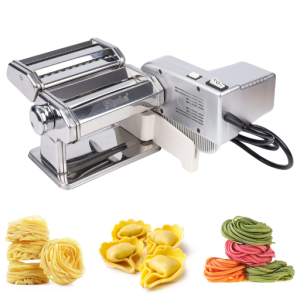
When selecting the best pasta maker machine, consider your cooking frequency, competence, and price. A manual pasta machine might be better if you appreciate being hands-on and value durability, especially when you are not afraid of extra effort and time. Conversely, if your significant concerns are convenience and rapidity, an electric pasta machine is probably worth splurging on, notwithstanding its relatively high cost and possible complexity. Analyze features such as thickness settings, die options, and ease of cleaning to choose the model that suits your specific pasta-making needs. Therefore, finding the right balance here will help you select the pasta maker that fits your kitchen and style of cooking best, especially among these models.
Key Features to Look for in an Electric Pasta Maker
- Ideal electric pasta makers combine mixing the dough and shaping the pasta within the same device, hence the built-in mixer and extruder. This feature saves time, making it more efficient from start to finish. This is one of those features that cannot be ignored in a good electric pasta maker because it helps in saving time for cooking and ensures that there are no messes from flour all over the place.
- These include spaghetti, fettuccine, penne, and lasagna, among others, for your favorite dish. A wide range of dies enables you to be creative with your recipes by experimenting with various textures.
- This will assist you in obtaining the right thickness; if it is too thick, the noodles might not be as tasty as they should be. The best electric pasta maker has several options for different noodle thicknesses. This is crucial because only this way can one make pasta of the needed consistency.
- For instance, newbies may look for easy-to-use interfaces while assembling parts, which is also essential. Cleaning becomes easier when parts can easily be removed and washed in dishwater.
- This ensures that they last long, reducing the chances of damage or breakdown. Durable construction prevents mechanical failures and consistently supports high performance.
- With larger quantities of dough at a go, faster machines would be much more convenient than slower ones due to reduced waiting times and quicker process durations. It means that fast machines do not compromise the quality of your pasta even though they sacrifice some time waiting for them.
- This may include weighing scales fitted into the machine that measure ingredients accurately, drying racks, or innovative ways of designing different shapes of pasta. In addition, having a scale inside an appliance that measures ingredients very accurately or even racks where foods can dry up while shaped accordingly enhances its convenience as well.
That way, you can choose a model based on these criteria, such as taste preference and cooking needs from the given list, thus providing satisfaction throughout this process.
Top Brands: Imperia, Kitchenaid, and Hamilton Beach Electric Pasta Makers
- Imperia: Imperia is a well-known brand that manufactures high-quality pasta makers used by professionals. It has an exhaustive collection of models that blend Italian handcraftsmanship with today’s technology. Take the Imperia Pasta Maker Machine, for instance; it is built using strong stainless steel and comes with a range of accessories to produce different shapes of pasta, among other things. Many customers have lauded its reliability and simplicity during operation, and hence, its popularity among both households’ amateur cooks and commercial chefs.
- Kitchenaid: The reputation of Kitchenaid as an all-around kitchen equipment supplier is upheld by its electric pasta makers, which are efficient and user-friendly. Kitchenaid Pasta Press Attachment goes together with the iconic stand mixer through six different interchangeable plates to ensure one’s experience while making pasta becomes easier. Consequently, buyers have praised the product for being convenient due to its ability to deliver quickly and because it originates from Kitchenaid; thus, selecting it would be wise for someone who wants to develop his/her cooking skills further.
-
Hamilton Beach: Hamilton Beach produces affordable electric pasta machines that appeal to various individuals regardless of income level. With these beginner-friendly features in mind, Hamilton Beach’s noodle/pasta makers feature simple controls that anyone can understand or clean easily. Among all automatic units, the Hamilton Beach Electric Pasta And Noodle Maker stands out since it mixes and kneads dough automatically before extrusion, allowing you to enjoy your homemade meal without any trouble-making process a smooth task. On practical grounds alone, but not limited, many consumers praise this device for speedily producing numerous varieties of noodles without demanding anything special from them.
Comparing Different Pasta Maker Attachments
While comparing different pasta maker attachments, it is vital to consider versatility, ease of use, and cleaning convenience. In terms of versatility, the Imperia Pasta Maker Machine stands out as it has multiple durable attachments to serve various pasta shapes; its robustness also makes it easy to use. The Kitchenaid product line includes a versatile Pasta Press Attachment with six interchangeable plates, thus making it fit for their stand mixers. Its high-performance abilities make it a favorite among users who praise its simplicity. Lastly, Hamilton Beach offers budget-friendly choices with automatic functions for mixing and kneading, which are also appreciated for being simple and fast. Different brands have individual advantages that suit specific user needs and preferences.
Step-by-Step Guide to Using an Electric Pasta Machine
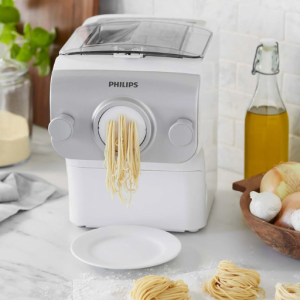
- Prepare the Dough:
- Put flour and eggs (and any other desired items) into the mixing bowl of the electric pasta machine.
- Adhere to the recommended proportion of flour to eggs for better outcomes in your machine’s guidebook.
- Start the Machine:
- Put flour and eggs (and any other desired items) into the mixing bowl of the electric pasta machine.
- Wait until it is finely mixed and well kneaded before stopping the machine from running.
- Rest the Dough (if required):
- Some machines recommend allowing dough to rest before extrusion. Observe the resting period provided by such a device.
- Select and Attach the Pasta Shape Disc:
- Select the preferred type of pasta-shaped disc and fix it on the extrusion outlet of your machine correctly.
- Extrude the Pasta:
- Set your machine on extrusion mode once you have prepared the dough.
- The dough is then put into an extrusion chamber, automatically becoming pasta with different shapes.
- Cut the Pasta to the Desired Length:
- As it comes out, use a built-in cutter or knife to cut pasta according to your length preference.
- Dry or Cook the Pasta:
- Depending on your recipe, you can either place freshly made pasta on a drying rack to use later or boil it instantly in boiling water.
- Clean the Machine:
- Switch off, remove the cord from the power source
- Take apart all pieces following the manufacturer’s instructions. Most parts can be safely washed in the dishwasher or rinsed easily, too.
By following these steps, you will ensure smooth operations while using an electric paste maker, making homemade pasta easily.
Preparing the Pasta Dough
You can make the perfect pasta dough with a handful of essential ingredients and some time. Start by putting your flour on a clean flat surface and creating a hole in the middle. Break the eggs into this hole; if you have olive oil or water, add them, too. Keep adding more and more flour to the eggs as you mix them carefully using a fork until they form some doughy mass. Use your hands to knead this mixture until it becomes smooth and elastic, which takes about 10 minutes. Once you get that right consistency for the dough, cover it with plastic wrap or damp cloth for at least 30 minutes before rolling.
Rolling and Cutting Pasta with a Pasta Roller
Making pasta sheets by rolling with a pasta roller is an easy process that turns your dough into perfect ones. Begin by splitting the rested dough into smaller manageable amounts, then flatten each slightly with your palms. The widest setting should be set on a pasta roller while passing through the rollers again, turning its handle. This is done several times by folding back through the rollers until it gets smooth and springy.
Gradually reduce the settings on the roller while continuing to roll out thinner and thinner pieces of dough at each try until you achieve your preferred thickness. Do not fold over once during the final pass for your last run to maintain even sheeting of all sides. If cutting pasta, attach a chosen cutter attachment to a pasta roller or use a sharp knife to cut sheets into desired shapes, such as fettuccine or tagliatelle. When using a knife, ensure lightly dusting with flour on top of rolled-out pasta sheets so that they do not stick together.
Alternatively, hang cut pasta on a drying rack for later use or cook immediately in boiling salted water for 2-3 minutes. Hence, follow these steps carefully to obtain well-done homemade pasta that is evenly rolled and cut easily.
Creating Fresh Pasta with Electric Pasta and Noodle Maker
Making pasta is made more accessible by using an electric pasta and noodle maker, saving time and energy. First, read the instructions provided by the manufacturer for putting up and assembling the machine. Generally, this would require you to place measured ingredients like flour with eggs or water directly into a mixing compartment of the machine. Attach the appropriate shaping disc to determine your preferred pasta shape.
Switch on the machine once all ingredients have been put inside and the necessary settings are done. It will mix the dough before extruding it via mold discs that give rise to defined pasta shapes. You may trim your pasta using either an integrated cutter or a sharp knife, ensuring that they’re cut according to your preference in terms of length. Consequently, various brands also incorporate variable thickness settings and automatic mixing/kneading/extruding functions in their electrical appliances, hence offering uniform outcomes.
To cook freshly made pasta, you simply have to steam it like in usual cases; e.g., boil it in salted water for about 2-3 minutes until it becomes al dente. An electric pasta and noodle maker can easily make a range of different kinds of pasta, like spaghetti and fettuccine, making it a good tool for individuals who are new to cooking or are experienced ones, too.
What Types of Pasta Can You Make with a Pasta Maker?
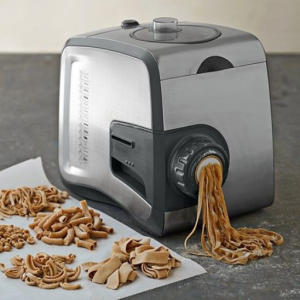
When you make pasta with a pasta maker, you can create many kinds to satisfy any taste. The typical ones include spaghetti, fettuccine, and linguine, suitable for various sauces. You may also make flat types of pasta like lasagna sheets or pappardelle, which are ideal for layered meals or heavy dishes. For more complex varieties, use ravioli and tortellini, which can be stuffed once unique accessories are used, enabling stuffing with your favorite ingredients. Moreover, an electric machine for making pasta allows for making other shapes, such as penne, fusilli, and macaroni, thus broadening the range of possible homemade pasta types.
Popular Pasta Shapes and How to Achieve Them
- Spaghetti: One of the most familiar pasta shapes, spaghetti can be quickly made using a pasta maker fitted with a disc-shaped attachment. Simply pass the dough through the machine and get long, thin stands suitable for eating with tomato-based sauce or carbonara.
- Fettuccine: Fettuccine should be prepared using a wide, flat disc. This type is quite good when served with Alfredo and other creamy sauces. After letting the dough go through your appliance, cut the pasta into long, flat ribbons.
- Linguine: A little less broad and flattened than fettuccine, linguine requires such attachments but narrower ones. It perfectly matches seafood sauces and pesto. Roll the dough through the machine to the preferred length.
- Lasagna Sheets: To produce lasagna sheets, use plain discs without any cutter attachment. The dough will come out as wide, flat sheets that are supposed to fit your baking dish size. This enables several layers of stuffing for more decadent lasagna recipes.
- Penne: For example, many electric pasta makers come with a penne attachment that has diagonal cuts at its round shape. Every time you push the dough out by leaving it in this device, it automatically cuts itself short until it forms small cylindrical pieces.
- Ravioli: Making ravioli requires an attachment that creates pockets for filling. Using ravioli attachments, a thin dough sheet is first rolled, then cut and filled with preferred ingredients like cheese, meat, or vegetables.
- Macaroni: Macaroni calls for the use of a small round disc along with a hollow center attachment. When extruded from that kitchen gadget, the dough comes out as little elbow-shaped pieces. Due to its shape, it is essential when cooked in the oven, like macaroni cheese dishes.
Making these popular types of pasta becomes much easier if you have proper appliances fitted with various devices, which supply variety and freshen up everyday home meals.
Using the Pasta Extruder for Different Pasta Shapes
Using a pasta extruder for various pasta shapes is an uncomplicated matter. First, prepare the dough by mixing flour, eggs, and water in appropriate proportions to make it as hard as possible. Pass small parts of it through the extruder using a desired attachment. For instance, fettuccine calls for a flat disk, linguine needs narrower ones, and penne requires a round disc shape. Once the dough has come out, cut it to whatever length you please. A successful extrusion will depend on how well the dough is made and your choice of tools, ensuring you get perfect consistencies that appear natural.
Tips for Making Homemade Pasta Sheets and Noodles
- Use Quality Ingredients: Begin with high-quality wheat, such as 00 flour or semolina, which is ideal for pasta making. Fresh, organic eggs can enhance the texture and taste of your pasta.
- Keep Correct Dough Consistency: Mix dough till it becomes smooth and elastic. If the dough is too dry, add some water. In case it’s too wet, add additional flour. A properly kneaded dough should not stick on your hands or the surface.
- Let Dough Rest: After kneading, allow the dough to rest for at least 30 minutes. This relaxes the gluten and makes the dough easy to roll out.
- Use a Rolling Pin or Pasta Machine: Roll out the dough with a pasta machine to ensure even thickness. Start at the thickest setting and gradually work your way to thinner settings. If using a rolling pin, aim for even thickness throughout.
- Flour Working Surface Plus Tools: Lightly dust your working surface, rolling pin, and pasta machine with flour to prevent dough from sticking.
- Cut Noodles Equally in Widths: To ensure evenly cooked noodles, cut them into similar widths. Use a sharp knife or a pasta attachment for precise cuts.
- Proper Pasta Drying: Cut noodles slightly, then let them dry if one intends to keep them for some time. Lay them flat or hang them on a drying rack to prevent them from sticking together. Fresh noodles can be cooked immediately.
By following these tricks, you can create expertly made homemade pasta sheets and noodles that will elevate your dishes beyond imagination.
Maintenance and Care for Your Pasta-Making Machine
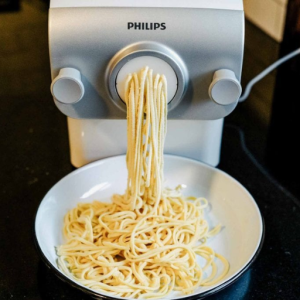
To continue your machine’s life and make it work properly, you must maintain your pasta-making machine. It is recommended that you follow these crucial suggestions below:
- Scrub after each use: Once you’ve finished producing pasta, be certain to wipe off any remaining dough residue. Use a dry brush or wooden skewer to remove dough pieces from the rollers and cutters.
- Avoid water: Never apply water or soap on the device because this will eventually cause rusting and damage. Instead, rub its exterior using a piece of dry fabric.
- Lubricate Moving Parts: Sometimes, food-grade mineral oil is used to lubricate moving parts to keep them functional at all times.
- Proper storage: Keep your pasta-making machine in a cool place that is free from moisture. Wrap it up with a guard cloth or keep it in its original carton, thus preventing dust from settling on it.
- Regular inspection: Regularly check for signs of wear or damage. Continuous tightening of loose screws/bolts will enable your machine to hold its stability over time.
By adhering to these care tips, one can ensure his/her pasta-making machine remains intact and continuously supplies fresh pasta for many years.
Cleaning Your Electric Pasta and Noodle Maker
Properly cleaning your electric pasta and noodle maker is essential for it to live long and work at its peak. Here are detailed steps to ensure thorough cleaning:
- Unplug the Machine: Whenever you start washing, always make sure that the electricity from the wall socket is unplugged so that you do not risk electric shocks.
- Disassemble Parts: Carefully disassemble any removable parts, such as mixing bowls, extruding discs, and other attachments. Your manufacturer’s guide will provide specific instructions.
- Remove Dough Residue: Use a dry brush or wooden skewer to remove dough residue from machine components. A motorized base should never be directly exposed to water.
- Wash Removable Parts: Hand wash all detachable sections using lukewarm water and mild detergent. Do not scratch the surfaces with abrasive cleaners.
- Dry Thoroughly: Allow all parts to dry completely before reassembling them. Moisture can lead to dough sticking during future uses or rusting of metal components.
- Wipe Down Exterior: A slightly damp cloth should be used to clean off the external part of the equipment. Do not allow water to enter mechanical or electronic elements.
- Reassemble and Store: After drying all parts, put them back together and keep them in an appropriate place that is neat and dry. The container may also be covered by protective fabric to prevent dust from settling on it.
To maintain your electric pasta and noodle maker in top working conditions and ready for making fresh, delicious pasta whenever you wish, just follow this cleaning procedure.
Storing Your Pasta Maker Machine Safely
To keep your pasta maker functioning optimally and prolong its lifespan, it is necessary to store it properly. Follow these steps to store your machine safely:
- Clean Properly: Make sure the pasta maker is cleaned thoroughly and dried completely before storage. Any leftover dough or dampness may cause mold or rust.
- Detach Gently: Disassemble all removable parts as per the manufacturer’s guidelines. This will prevent damage or loss of parts.
- Original Packaging Should Be Used: Whenever possible, keep the machine in its original packaging, which provides cushioning and protection and shields it from dust or scratches.
- Dry Cool Place Select: Find a dry, cool place to store the machine where there is no direct sunlight or humidity, e.g., kitchen cabinets/shelves in pantries.
- Cover Using Something Otherwise If You Cannot Get The Original Packaging: If you have no access to the original packaging, you can wind up using a protective cloth as well as a dust cover on top of that to avoid dirtiness with time.
By following these storage rules, one can be sure that their electric pasta maker is safe at all times and ready for use when needed.
Long-term Maintenance Tips for Manual and Automatic Pasta Machines
Whether your pasta maker is manual or automatic, properly maintaining it will help you get the most out of it. The following are some long-term maintenance tips.
- Regular Cleaning: Clean every part of the pasta machine after using it every time. Use a brush or wooden skewer for manual machines to clean dough remnants from rollers and cutters. In cleaning up an automatic machine, refer to the user manual for guidelines on cleaning each component.
- Avoid Water Exposure: Don’t use water, especially for manual machines, because they can rust. Instead, use a dry cloth or soft brush to clean the machine. All removable parts that can be washed in the dishwasher must be fully dry before being reassembled on an automatic machine.
- Lubricate Moving Parts: Once in a while, lubricate the moving parts of your pasta maker with a drop of food-grade mineral oil to keep them running smoothly and prevent premature wear.
- Inspect for Wear and Tear: Regularly check your machine for wear and tear, especially on cutting blades and rollers. Change damaged or worn parts immediately to avoid further damage and ensure consistent pasta quality.
- Store Properly: As earlier indicated, store your device in clean, dry places. For manual machines, people keep plastic bags that collect dust covered.
By consistently adhering to these long-term maintenance tips, you can keep your pasta maker in excellent condition and ensure it continues to produce high-quality pasta for years to come.
Frequently Asked Questions (FAQs)
Q: What should I consider when choosing an electric pasta maker for my family?
A: When selecting an electric pasta maker for family noodle making, consider the machine’s capacity, ease of use, cleaning process, and the types of pasta it can produce. Look for features like multiple pasta cutter attachments and durability.
Q: How does an electric pasta maker machine compare to a manual one?
A: An electric pasta maker machine automates the process of making pasta, saving time and effort compared to a manual pasta maker. Electric models can be more efficient and consistent, while manual machines offer more control and can be more budget-friendly.
Q: What is the Philips 7000 series pasta maker known for?
A: The Philips 7000 Series pasta maker is known for its versatility, ease of use, and high-quality pasta output. It stands out for its automatic operation and ability to efficiently mix and knead fresh pasta dough.
Q: Can an electric pasta maker create different types of pasta?
A: Yes, an electric pasta maker is an automatic noodle machine that often comes with various attachments and settings that allow you to create multiple types of pasta, including spaghetti, fettuccine, lasagna, and more. Some models even come with a pasta cutter for added variety.
Q: How do I clean an electric pasta maker’s automatic noodle machine?
A: Cleaning an automatic noodle machine for an electric pasta maker usually involves dismantling the removable parts and washing them with warm water and mild detergent. Some parts may be dishwasher safe, but always check the manufacturer’s instructions.
Q: Is it easy to make fresh pasta dough with an electric pasta maker?
A: Making fresh pasta dough with an electric pasta maker is generally straightforward. These machines often feature a built-in dough mixer and kneader, simplifying the process and ensuring consistent results.
Q: How does a compact pasta maker benefit a small kitchen?
A: A compact pasta maker is ideal for small kitchens. It takes up less space while still offering the functionality of larger models. It’s perfect for those who want to make fresh pasta dough without sacrificing counter space.
Q: What advantages does a Kitchenaid pasta roller offer?
A: The Kitchenaid pasta roller attaches to Kitchenaid stand mixers, allowing for precise rolling of pasta dough to the desired thickness. It is convenient and versatile and can be used with various Kitchenaid pasta cutter attachments to make different pasta shapes.
Q: Are there specific models recommended for making dough for noodles?
A: Yes, models like the Philips 7000 Series and other high-quality electric pasta makers are recommended for making dough for noodles. These machines are designed to mix, knead, and extrude dough for various noodles efficiently.
Q: What brands are known for the best electric pasta makers?
A: Some well-regarded brands for the best electric pasta makers include Philips, Kitchenaid, and Imperia. These brands are known for their reliability, quality, and versatility in pasta making.












